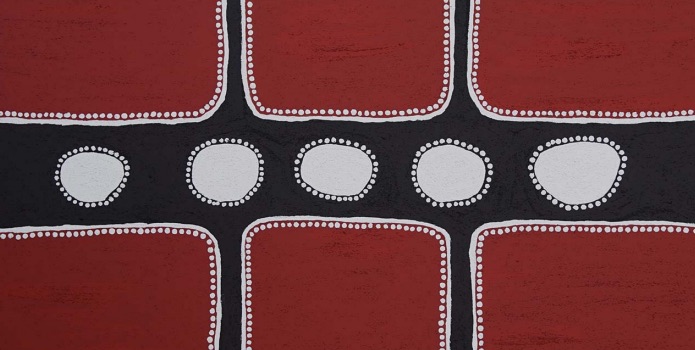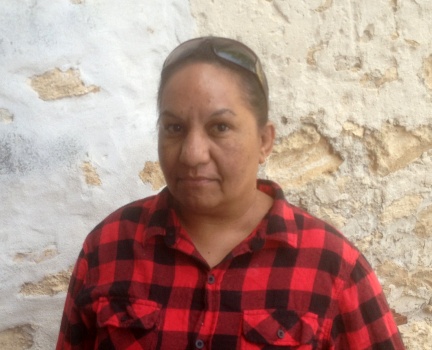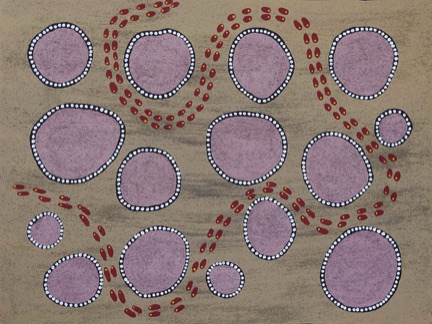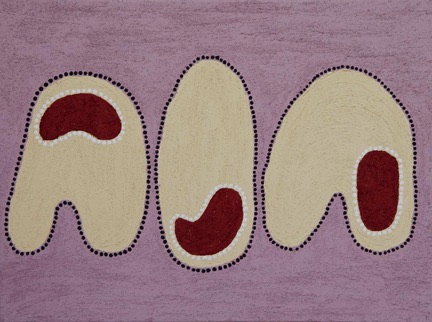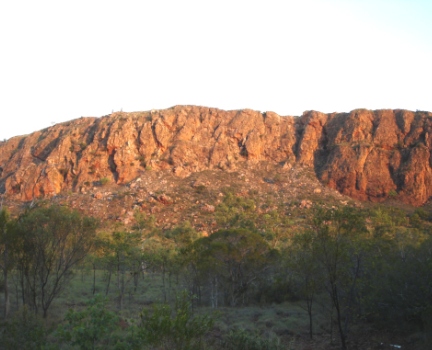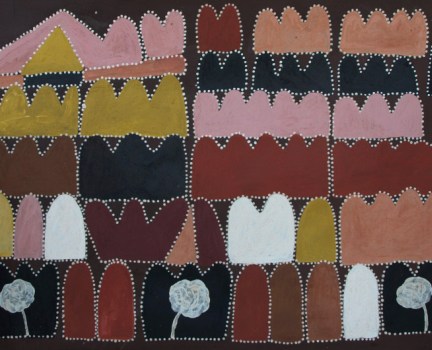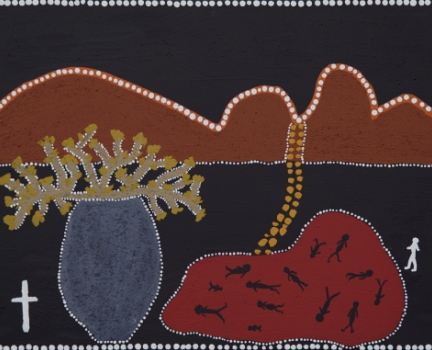Marcia Purdie & The Storytellers of Warmun
In this interview Marcia Purdie talks about her love and respect for the elders of Warmun. She discusses the influence of her mother-in-law, artist Shirley Purdie, and her memories of Queenie McKenzie.
Q. You spent some time with the old people from Warmun, can you tell me a little about what that was like and how it has influenced you?
I visited and stayed in Warmun, Turkey Creek, from when I was about sixteen or seventeen. I grew up in Wyndham but my Mum and Dad sent me back out there to work when I left school. They didn't want me hanging around in town. They wanted me to go and look for work. Turkey Creek is where a lot of our family live. They sent me out there and I'm still there right up until today.
I met Dallas Purdie and we had five kids. We married, but we're no longer together. I take the Purdie name, my maiden name was Rivers. Warmun is still home to me, I've got a feel for it. That's my kids home. We're Gija*. We're related to a lot of the Gija people there. The majority of Turkey Creek is Gija community.
*Gija is a language group.
The Old People & The Dreamtime Stories
Q: Did the old people of Warmun influence your painting?
When I was in the family way and when I had babies I was able to go and work at the school. Sometimes I’d even just go and sit at the bough shed and listen to the old people. That's one of the things you do in our community. You'd get out of the house and meet everyone at the bale shed for a gathering.
A lot of the old people have passed away now. Back then, when they were all alive, they had a lot of input into the community. There was a really strong feeling in the community and we treasured our old people. They were our history. The way I look at it, that's why the funerals for our old people are a big deal. We mourn properly for our elders. They are part of our history and that history dies when they die.
That’s why it’s important to sit down with them and hear a lot of Dreamtime stories. These are stories that have been passed down to them from generations ago. You get to know these stories by sitting down with the old people. I've heard a lot from my grandmother. Being there at Turkey Creek and meeting up with the other older people taught me a lot too. They knew my grandmother and were related to her. I had that connection with them straight away.
Queenie McKenzie - An Eagle, Cheeky Goats and The Colour Pink
Q: As an artist, who taught you about the ochres and the colours?
I first started painting about 15 years ago. I'd always liked to be around the older people when they were painting at the school. That was when I made my connection with Queenie McKenzie. I used to just love watching her paint and listening to her telling stories at the same time. She had a big connection with the school and I worked there so I saw her a lot. I use pinks in a few of my paintings. I've been inspired to because it reminds me of her. To me, pink represents Queenie. I've never known the other old people use that colour.
She was such a live wire. She was full of cultural knowledge. She didn't stop right until the day she died. She died of a heart attack. That's the only thing that was ever going to stop her. She was always walking everywhere. She was really active for her age. I remember she used to be so lively, old Queenie.
Q: So Queenie was a major influence?
I think you get influenced from your family line. You take that direction. My grandfather and my grandmother paint. You carry it on.
I think back to my connection with Queenie. I was working in the same place with her. To me, she stood out from the rest of the people in the community. She used to have a pet eagle that lived on her roof. It was a big eagle. She was also known for her goats and they used to be really wild and cheeky. They used to chase people.
I remember they chased me on my 18th birthday. On that day I was hanging up in a tree down in the creek for about an hour. Queenie was at the school and all I was thinking was, “when is this old girl going to come back and sort these goats?” One goat, in particular, was really cheeky, Nanny, Nanny, they used to call her. It was rearing up and kicking up dust. Eventually, an old fella came along and he threw a rock at them.
The Guidance of Shirley Purdie
Q: Your mother-in-law Shirley Purdie started you painting?
Yes, I sat with her a lot when I started painting. Then there was a period when I didn't paint for 10 years. This month is the first time I've picked up a paintbrush and painted again. I stopped when my marriage broke down and it was something that I couldn't find in myself to do. In the past, I have found it like a healing thing. I think I did really good works during those early times without even realising. You just put all your energy into that board.
Q: What did Shirley teach you?
I used to sit down and I'd ask her things. I've learned a lot from her. She was not only my mother-in-law, she was like my mentor. She still is to this day. I look up to her for guidance.
She encouraged me to take up painting. She was happy to share what she knew. When I see some of the works that the old people do, I ask myself what are they thinking of? She told me, you get a vision in your head and you put them down how you want to put them down. You put down what you see and hear. What you see in my paintings, I've learned that from her. I think about the stories and try to put those stories in my painting. I think about how I’m going to do it before I get the board.
Q: Do other people work like that or do they make it up as they go?
I can't speak for everyone but I reckon that's how most of the old people do it. When I go and sit down with them and they're starting their painting I see them prepare all the paint they’ll need. They know their colours, what they want to put on that board, so they prepare all those colours first. They already know what they're going to put on that board and I've picked up that up that approach from them.
I've seen some other people get a board and they'll stare at their board and then they'll mix paint and they'll paint over that paint. That's not how the old people do it, they know what they're doing. I’ve noticed they get their paint organised first and they've already got the picture in their head.
They also make up larger quantities so that if they have to paint over they’ll have that same colour there. Once you make a colour, and you run out of that colour, you can't go and make that exact same colour again.
Stories Of Clan And Country
Q: How do these stories of country influence your art?
At the beginning, I had to get a feel for painting and get comfortable with myself. After that I had that confidence then I could think about these stories. You think about what you hear, and you visualise those stories in your head. You don't go and paint the stories of other people or other places. You paint the stories from your clan and your country.
Q: So you're influenced by the family line and you're influenced by the stories of your region and those things helped define you as an artist?
Yes. You'll never go and see us painting anything out of our area. The stories have to come from our area and there's plenty of stories to tell. Whether it's a Dreamtime story or just a place that you're fond of, it can also be a community or a massacre story.
Massacre At Mistake Creek
There is one particular story about the massacre at Mistake Creek. There was a pastoralist. He had a dairy cow with a bell on it. That cow went missing. An old black tracker came out and found a little family, a little tribe sitting there having a feed of meat under a boab tree near Mistake Creek. He couldn't find that cow so the tracker went back and told the manager that they had stolen and killed the cow. He said they were eating it.
The Manager came and shot the lot of them on the spot. One of them, a female, was shot but not killed. She had a broken hip so she couldn't walk. She crawled probably 30 kilometres to another group. She told them the story otherwise no one would have known about it. If she hadn't crawled over the hills and known where to find people that the story wouldn't have been told.
Q: The paintings are a way of preserving these stories and passing them on.
Definitely yeah. That's probably our only way, because paintings, they can last forever. You still see the paintings in caves.
Next Generation of Warmun Storytellers
Q: Are the young people in your community interested in painting? Is there another generation coming through?
Yes, there is, and it's good. In my group, everyone has their different ways and some younger generations have modernised. It's still the same stories and they've made it look even better in some ways. Still, you still can't beat old traditional ways of painting.
You can see the difference between the older paintings and what we do now. We experiment with different colours. Mostly the old people probably used the same colours but we do a lot of experimenting, mixing and making things.
Q: What do you find yourself thinking about when you're painting?
It's a relaxation. It also makes me think about my culture. I think about the stories that I hear and how I’m going to interpret those for somebody else. I think about how they will see that painting and learn the story.
Q: Is it hard to let them go and sell your paintings when they are finished?
Yes. Sometimes you just want to keep the lot. Some painting you do and you get a feeling, “This can really help me too." There was a period in my life when I had a lot of depression and I found that I did really good paintings. I had a lot of connection with those paintings even though they were about this story or that story. It was like healing for me.
Future Recognition
Q: Where do you want to take your art to? What’s in your mind when you think about going forward with it?
To be honest I'd like to get recognised. It's something for me to work towards. I've got my kids now so I'd like to get recognised for their sake and then they can carry it on.
Read more:

